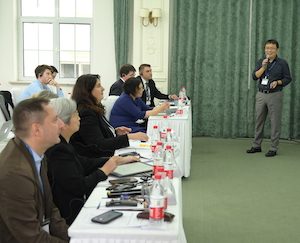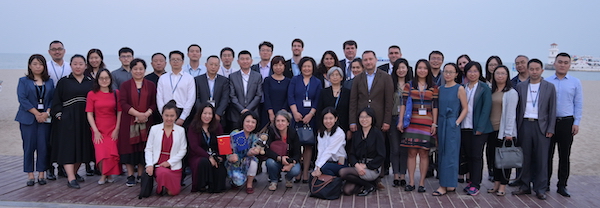EU-China Talks on Financing Energy Efficiency ![]()

The first energy efficiency themed workshop titled “Market Based Financing Solutions for Energy Efficiency” organized by the EU-China Energy Cooperation Platform (ECECP) was held in QinHuangdao City of Hebei Province on September 20th, where experts and scholars from China and the European Union shared their inspiring practise and experience respectively on some common issues around building energy conservation, energy efficiency upgrade as well as market based financing measures, and engaged with a hot discussion. The abundant distinguished cases and innovative financing models illustrated by keynote speakers have shed light on future energy efficiency promoting measures for the two sides, which highlighting the need of more in-depth dialogues between EU and China in the relating fields to work towards better solutions.

Addressed in the welcome remark, Octavian Stamate, Counsellor for Energy and Climate Actions of EU Delegation to China, noted that energy efficiency was always an important pillar of EU’s energy policy. In fact, EU has been taken various initiatives in many areas to improve energy efficiency, as an important mean to tackle climate change challenges and to create a better life for the people. According to Stamate, by carrying out series of events ever since the official lunch in May, ECECP has established a valuable negotiating platform for the pragmatic cooperation between EU and China in the energy sector, creating good opportunities to learn from each other’s experience, which serves well to the clean energy transition of both Europe and China.
 EU’s energy and climate policy has always been geared towards promoting emissions cuts and energy efficiency. Sticking to the mid-term target of increasing energy efficiency by 32% until 2030, EU has recently made encouraging progress in a number of areas to implement energy savings. Diana Barglazan, policy officer of the Directorate-General for Energy of European Commission, said the main reason behind this progress was a complete set of reasonable and effective systematic policy measures and supporting frameworks with clear responsibilities and obligations as well as coordination between the EU as well as its member states. After giving a detailed interpretation of EU’s energy and climate policy, Diana introduced more about the financing tools of energy efficiency projects in the building sector, and the energy efficiency mortgage plan in particular, which the Chinese audience found not quite familiar with. The EE mortgage plan, as Diana explained, is supported by Horizon 2020, the biggest EU Research and Innovation programme, which aims to design, test and promote the standardization of EU energy efficiency mortgage products by providing mortgage loans to purchase and build or renovate residential or commercial buildings. The plan also plays an important role in reducing carbon footprints and in improving people’s living conditions, while reducing energy bills for the households.
EU’s energy and climate policy has always been geared towards promoting emissions cuts and energy efficiency. Sticking to the mid-term target of increasing energy efficiency by 32% until 2030, EU has recently made encouraging progress in a number of areas to implement energy savings. Diana Barglazan, policy officer of the Directorate-General for Energy of European Commission, said the main reason behind this progress was a complete set of reasonable and effective systematic policy measures and supporting frameworks with clear responsibilities and obligations as well as coordination between the EU as well as its member states. After giving a detailed interpretation of EU’s energy and climate policy, Diana introduced more about the financing tools of energy efficiency projects in the building sector, and the energy efficiency mortgage plan in particular, which the Chinese audience found not quite familiar with. The EE mortgage plan, as Diana explained, is supported by Horizon 2020, the biggest EU Research and Innovation programme, which aims to design, test and promote the standardization of EU energy efficiency mortgage products by providing mortgage loans to purchase and build or renovate residential or commercial buildings. The plan also plays an important role in reducing carbon footprints and in improving people’s living conditions, while reducing energy bills for the households.

On the first session of the workshop, Danfoss Heating Segment vice president Yongming John Yu took the stage to present AI solutions for heat control and management of the building sector. According to Yu, by installing indoor sensors and leveraging a big data controlled platform that integrated weather data and district heat data as well, Danfoss’ Leanheat AI solution can perform artificial intelligence analysis for detailed management, which can eventually save energy up to 30% at a relatively low cost while ensuring that the indoor temperature is comfortable.
 Ivanka Pandelieva from Sofia Energy Centre (SEC) of Bulgaria, shared with the audience the successful practise model of One-Stop-Service (OSS) platform for energy efficiency buildings, which can almost cover all the needs of the customer chain, including information, technical assistance, financial support, energy conservation monitoring and so on. The service providers and financiers at the OSS platform covers a wide range of players, including organisations, consortia, projects, and even independent experts. According to Ivanka, the OSS funded by Horizon 2020 and European Structural and Investment Funds, aims to create a registry of OSS that actually works in the field and provide basic information about them in a uniform analytical format. The OSS also conduct large scale capacity building programme through a series of workshops.
Ivanka Pandelieva from Sofia Energy Centre (SEC) of Bulgaria, shared with the audience the successful practise model of One-Stop-Service (OSS) platform for energy efficiency buildings, which can almost cover all the needs of the customer chain, including information, technical assistance, financial support, energy conservation monitoring and so on. The service providers and financiers at the OSS platform covers a wide range of players, including organisations, consortia, projects, and even independent experts. According to Ivanka, the OSS funded by Horizon 2020 and European Structural and Investment Funds, aims to create a registry of OSS that actually works in the field and provide basic information about them in a uniform analytical format. The OSS also conduct large scale capacity building programme through a series of workshops.

In addition, Slavisa Kostadinovic from Sabac City Council and Slobodan Jerotic from Serbia Sabac District Heating Company and also shared the eastern Europe city’s successful case in financing and facilitating energy efficiency projects in the building sector, which highlights great importance of close collaboration between the government and the utility part in fostering such projects.


Zhang Xiaoling, director of Centre of Science, Technology and Industrialization Development, used the case analysis of Qinhuangdao passive building development to illustrate China’s passive building renovation and financing practice. She explained the main financing tools of constructing such projects are capital investment of the developers as well as the subsidies and preferential polices at different government levels, and emphasized that building energy efficiency projects is a “work for the moment that benefit tomorrow”, which not only provides a physical solution to effectively prolong the life-span of the building, but also serves for better life.
 The transportation sector is another crucial part to solve the energy efficiency puzzle, which is right now facing more challenges than the electricity sector to meet the EE targets. Boyong Wang, director of China Smart Freight Center, spoke of the financing energy efficiency in freight sector at the event. Under the circumstances that the whole society is promoting green and low-carbon development, the pressure on energy conservation and emission reduction of freight transportation is enormous, and “the transportation sector in China is a huge market, and the energy saving efforts in this field is crucial for China emission peaking and improve energy efficiency”, as Wang noted during the last session.
The transportation sector is another crucial part to solve the energy efficiency puzzle, which is right now facing more challenges than the electricity sector to meet the EE targets. Boyong Wang, director of China Smart Freight Center, spoke of the financing energy efficiency in freight sector at the event. Under the circumstances that the whole society is promoting green and low-carbon development, the pressure on energy conservation and emission reduction of freight transportation is enormous, and “the transportation sector in China is a huge market, and the energy saving efforts in this field is crucial for China emission peaking and improve energy efficiency”, as Wang noted during the last session.


The day before the event was held, the delegation of the workshop also went on a field trip to visit the first passive building project of China namely the China-River Side Community at QinHuangdao City, where the manager of the real estate developer introduced various energy saving measures applied in the project in detail to the guests, including solar building integration, energy efficient electrical equipments application, rainwater collection and utilization system etc..

Activity Arrangements
活动安排
Thursday 19 September 2019 | 2019年9月19日 星期四
- 8:30: Depart Beijing by coach from Guo Mao Subway Station (Exit C of line 1)
8:30: 大巴从国贸出发,前往秦皇岛 (集合点:国贸地铁站1号线C出口) - 13:00: Hotel check-In and lunch (Hotel Hai Tian Yi Se)
13:00: 办理酒店入住/午餐 (秦皇岛海天一色酒店) - 14:30: Visit to commercially financed passive building residential estate in Qinhuangdao
14:30: 大巴从酒店出发,前往该市被动房项目参观 - 18:00: Dinner (location TBC)
18:00: 晚餐(地点待定)
Friday 20 September 2019 | 2019年9月20日 星期五
- Conference – “Market Based Financing Solutions for Energy Efficiency in EU and China”
欧盟与中国节能市场融资研讨会
Saturday 21 September 2019 | 2019年9月21日 星期六
- Bus departure at 14:30 for Beijing from the hotel
大巴于下午2:30从酒店出发,返回北京